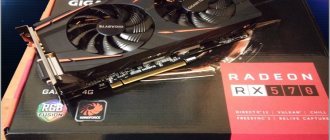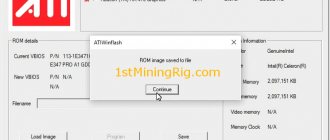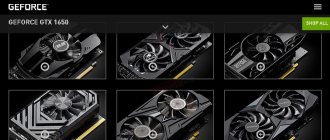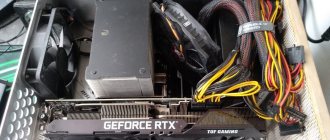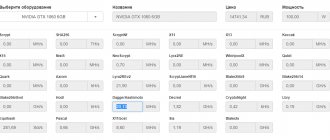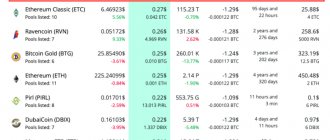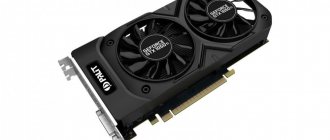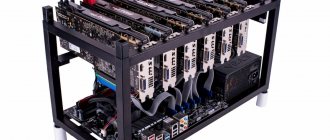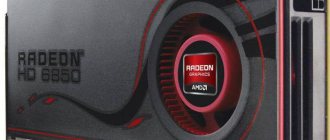Video card characteristics
The video card may differ in the amount of RAM on board. The first version with 4 GB, and the second with 8 GB are a little more expensive. The characteristics of the video card are as follows:
- Video memory frequency : 1220 MHz.
- Video processor clock frequency: 1266-1342 MHz. (depending on the manufacturer).
- Additional power : 8 pin.
- Processor : Elesmere Polaris10.
- Interface type: 256 bit.
- RAM bandwidth : 240 GB/s.
- Power consumption: 130 W.
What are the performance of a video card in mining?
The best option when choosing an algorithm for mining on the Radeon RX 480 is considered to be Ethash . There are other algorithms that can bring good income. For example, the new coin protocol RVN, CawPow, as well as ProgPowZ, but Ethash remains the most profitable algorithm for these cards.
Previously, ether could be mined not only solo, but also through dual mining, which actually would not affect its production. Dual-mining with Ethereum was excellent for Decred and XVG. But in 2020, double mining lost its profitability. The only profitable way to mine two crypto coins at once is to run Merged mining of Zill+ETH . The features of the Zilliqa blockchain project make it possible to combine coin mining. Most of the time, your rig will mine Ethereum by cycling to Zill.
If you configure and overclock the video card correctly, you can achieve fairly good mining speeds of 30 Mh/s on a video card with 8 GB, and 28 Mh/s on the 4 GB version. But keep in mind that 4GB cards will soon no longer be able to mine ETH/ETC.
Standard video card settings allow you to overclock the video processor frequency to 1100 MHz, but this is not the card's maximum in mining. If you use MSI Afterburner or Wattol , you can increase this value even more, but we do not recommend it since this is the maximum optimal frequency. They pay more attention to this when it comes to other coins using other algorithms.
Which model to choose, the main nuances when buying a used one
The older model with 8 GB, when tested in Claymore's Dual Ethereum AMD+NVIDIA GPU Miner , showed the following indicators:
- The video card processor frequency is 1169 MHz.
- RAM frequency is 2050 MHz.
- Hashrate – 30.1 MH/s.
- Power consumption ~ 130 W.
During Ethereum mining, the processor frequency does not exceed the maximum permissible, since during overclocking it is possible that the video card will produce invalid “balls”.
When mining ether, the changed parameters will not change anything, but if you take into account the work in dual-mining mode, then these changes will have a positive effect on the work in other algorithms that depend on memory speed.
The younger model with 4 GB showed the following values:
- The video card processor frequency is 1100 MHz.
- RAM frequency is 1800 MHz.
- Hashrate – 27.5 MH/s.
- Power consumption ~ 120 W.
The values do not differ much, but a lot also depends on the manufacturer of the video card and proper overclocking. For example, an MSI is equipped with two fans and the device always remains cold. PowerColor is equipped with 3 fans, however, it is the hottest video card, despite the large number of coolers. Due to heating, PowerColor is the worst suited for mining. Gigabyte showed its best side in mining even after the correct firmware.
If you take a video card from AMD, then it is better to choose the version with RAM from Samsung. The memory has good overclocking potential.
Of course, it is almost impossible to determine the supplier of memory chips for a new video card in a store. You can only roughly navigate by the brand of the manufacturer. When buying on the secondary market, everything is much simpler. Launch the desired program, for example, GPU-Z , and all technical information about this graphics adapter will appear on the display.
The RX 470 and RX 480 are essentially in the same price range and almost identical in performance. But if we compare for mining, then the first one will be more profitable in terms of price, and the second one in terms of performance. In any case, finding 470 on the market is even more difficult than 480, so it is more advisable to pay attention to the second option.
RX 4xx series graphics cards are no longer manufactured in factories in China, they have been replaced by the newer RX 5xx series models. Mining tests show that the difference between old and new models is minimal, so the demand in the secondary market is very high. You should be careful when purchasing such video cards for mining. Pay attention to external damage (safety of seals) and the warranty period according to the receipt.
Packaging and equipment
The Gigabyte Radeon RX 480 G1 Gaming 8G graphics card comes in a small package with a glossy finish, black printing and a signature cybernetic eye on the box. Over and over again, developers approach the design of models more and more creatively, and the “all-seeing eye” becomes more and more evil. The front side shows the name of the product, the amount of video memory equal to 8 GB, which has become a desired level for gamers for comfortable gaming in FullHD resolution, a list of technologies, factory overclocking, a Windforce cooling system and adjustable RGB Spectrum backlighting.
Turning to the back of the package, we note all the same points, but with a detailed description, signatures and visual images. The cooler is built using direct contact technology with three heat pipes, two 90 mm fans and an improved impeller shape; we note the presence of a backplate and active indication of the turntable stopping in idle mode. Gigabyte reports on the use of a special selection of GPU Gauntlet Sorting graphics chips, which implies the selection of the best processors for its line, full customizable RGB Spectrum backlighting with many types of settings. Brief technical specifications are provided in 13 different languages, including Russian; at the bottom there is a diagram for connecting monitors and system requirements. According to them, a power supply is recommended with a power of 500 W or more with one eight-pin connector.
Inside the dark packaging there is a black box made of thick cardboard with the symbols and name of the G1 Gaming series.
The video card is placed in an antistatic bag, and the entire package is hidden under soft material. It consists of only two items and offers a user manual and a driver disk.
What to mine on AMD RX 480, choosing an algorithm
The main algorithm for which a video card is suitable is considered to be Ethash. But during periods of growth, the profitability of algorithms changes quickly. Specialists constantly monitor current and profitable coins.
| Mining algorithm | Production speed | Core Clock | Memory Clock | Power Limit | En. consumption |
| Ethash: (Etherum, Ethereum Classic Ubiq, Expanse, Pirl, Ellaism, Metaverse, Callisto) | 30.1 Mh/s | 1100 | 2150 | +40 | 135W |
| CryptoNightSaber: (BitTube) | 960 H/s | 1100 | 2100 | +40 | 110W |
| Cuckaroom29: (Grin-CR29) | 2.6 H/s | 1200 | 2100 | +40 | 110W |
| ProgPow: (Sero) | 7.9 Mh/s | 1100 | 2100 | +40 | 140W |
| Zhash: (Bitcoin Gold, Anon, BitcoinZ) | 21 h/s | 1100 | 2100 | +40 | 130W |
| CryptoNight GPU: (RYO) | 760 H/s | 1100 | 2100 | +40 | 150W |
| NeoScrypt: (Halcyon, Dinero, Vivo) | 820 kh/s | 1100 | 2100 | +40 | 120W |
| KawPow: (Ravencoin) | 9 Mh/s | 1100 | 2100 | +40 | 140W |
| CryptoNightHaven:(HavenProtocol, Bloc) | 960 H/s | 1100 | 2100 | +40 | 130W |
If you plan to mine ETH, then it is best to purchase the “older” model with 8 GB; it is better suited for mining than the “younger” version. Claymore Dual Miner program is perfect for mining ; all settings can be left as standard. With these parameters, the video processor frequency will be 1100 MHz, and the video memory 2100 MHz, which will provide:
- speed 30.1 Mh/s;
- Energy consumption - 130 Watt.
An online mining calculator will help you calculate the profit you can get from mining a coin. Mining and hashrate at 30.1 allows you to mine 0.0028 ETH coins per day. Considering the current exchange rate, this amounts to $0.2/day. The market is now experiencing severe problems and many will turn off their farms. But experts believe and hope that this is a temporary period.
When the video card first went on sale, there was no point in mining anything other than Ethereum. But after the appearance of NiceHash, the range grew, and good money could be earned CryptoNight
At the moment, ETH has once again become the leader, and it is most profitable to mine two coins at once (ETH+ZILL). Therefore, the best algorithm for RX 480 is Ethash.
Printed circuit board
The PGigabyte Radeon RX 480 G1 Gaming 8G model is built on an original black PCB. A high-quality element base is used, which is built according to the proprietary Ultra Durable VGA concept, which involves the use of solid-state capacitors, chokes with a ferrite core and field-effect transistors with low open-channel resistance.
The graphics processor is presented by AMD with the code name Polaris 10. It has 2304 threading processes, 144 texture units and 32 ROPs. The chip was produced in week 30 of 2016.
The power subsystem is built according to the classic “6+1” scheme, where six phases are allocated for the graphics processor and one for video memory.
The IR 3567B microcircuit was used as a PWM controller.
The video memory capacity is 8 GB and is equipped with eight chips manufactured by Samsung labeled K4G80325FB-HC25. They operate at a clock frequency of 2000 MHz, effective - 8000 MHz.
BIOS firmware
The firmware represents a change in the value of the timings, which determines mining. To flash the video card firmware you will need four programs:
- ATIWinFlash
- CPU-Z
- Poraris Bios Editor
- Atikmdag-patcher
Next you need:
- Launch AtiWinFlash and save the BIOS file.
- If there is more than one card, then you need to flash them one by one, and it is advisable to make a backup of the BIOS files of each video card.
- Afterwards, open the saved BIOS file Polaris Bios Editor
- Copy the value 1500 and paste 2000, 1750 and 1625 and save the file.
- Launch ATIWinFlash and “load image”.
- After downloading and installing, the firmware will be completed.
- Before rebooting, you must run Atikmdag-patcher , otherwise the system may not detect the video card.
Flashing the BIOS will void your warranty, so be careful.
The SRBPolarisV3.5 application allows you not only to edit timings, but also to reduce memory and core voltage. However, the latest versions of Claymore's Dual Miner 15 and PhoenixMiner_5.0e_Windows allow you to perform undervolting and change timings on the fly. Add the necessary parameters to the executive file and the program will do everything itself. In this case, you will not lose your right to warranty service.
Cooling system
On the Gigabyte Radeon RX 480 G1 Gaming 8G video card, the cooling system is one of the most compact with a graphics accelerator length of 233 mm. The cooler is secured with six screws; a separate difficulty when dismantling the cooler is caused by three wires with lighting and power supply for the fans.
The base of the cooler has direct contact technology, bringing three heat pipes into contact with the GPU. The chip area almost completely covers them.
The video card power subsystem is one of the hottest and most vulnerable areas. To cool the Gigabyte Radeon RX 480 G1 Gaming 8G, the developers extended the fins of the main cooler and soldered the plate. A gray thermal pad is used as a thermal interface.
Heat removal from memory chips is organized in a similar way. Few models are cooled on video cards, but the developers from Gigabyte did not neglect this factor.
The cooler is a single-section radiator with many aluminum fins. It is pierced by three heat pipes with a diameter of 6 mm each.
All connections are carefully soldered, which has a positive effect on heat transfer and cooling of the Gigabyte Radeon RX 480 G1 Gaming 8G as a whole.
Two cooling system fans are attached to the decorative plastic casing. In addition to the Gigabyte inscription on the rotors, they received an improved impeller shape, which, according to the developers themselves, resulted in lower noise levels and increased air flow.
The turntables are manufactured by Power Logic. The models used are PLD09210S12H, widely found on other video cards. The current is 0.40 A at a voltage of 12 V. The rotation speed is 0 - 3400 rpm.
The metal plate not only protects the video card from damage due to PCB deflection, but also participates in passive cooling. For this purpose, the developers placed a strip of thermal pad between the backplate and the printed circuit board.
Overclocking in working order
To understand how to overclock an AMD video card, you need to learn how to manipulate the operating frequency of RAM. For overclocking, use the MSI Afterburner or Wattol , which can be downloaded from the official websites.
For overclocking in Afterburner the following values are used:
- Core frequency (Core Clock).
- Memory frequencies (Memory Clock).
For the most profitable overclocking when mining ETH, you should increase the Memory Frequency parameter by +30 MHz. The optimal value if the video card was correctly flashed is about 2050 MHz. To mine other algorithms, you will often need to increase the frequency of the video card processor, but remember that with this increase, power consumption increases significantly.
Testing
The Gigabyte Radeon RX 480 G1 Gaming 8G model has not only a redesigned printed circuit board and a non-reference cooling system, but also an increase in the core clock frequency from 1266 MHz to 1290 MHz, the voltage on the chip is 1.15 V. And the memory frequency remains the reference and is equal to 2000 MHz.
For our testing, the Gigabyte Radeon RX 480 G1 Gaming 8G video card was flashed to the current BIOS version “F8”, downloaded from the official portal. In the new firmware, developers continue to work on the fan speed algorithm, selecting the optimal parameters. On the positive side, the so-called “start-stop” situation of the turntables has been eliminated, when when they reached 50°C they were activated, and when 49°C they were turned off, and this was repeated cyclically.
When idle, the temperature stays at 47°C. We artificially increased the load on the Gigabyte Radeon RX 480 G1 Gaming 8G and at 50°C the fans started, but stopped only at 46°C, thereby delaying the activation point.
In games and benchmarks, the Gigabyte Radeon RX 480 G1 Gaming 8G video card maintains the stated frequencies of 1290 MHz for the core and 2000 MHz for the memory without drawdowns. After an hour of playing Battlefield 1 at ultra settings, the GPU temperature reached 72°C with a fan speed of 2050 rpm and an average noise level. The VRM zone warmed up to 73°C.
How to reduce energy consumption
The consumption of the RX 480 in mining is very important when it comes to optimal performance of the video card and a stable income. With Afterburner you can reduce CPU voltage consumption.
The following point is fulfilled:
- Limit .
Each video card has a margin to reduce power consumption. Only the computational values of one algorithm are used for mining, so it is possible to reduce the load when mining any algorithm. By decreasing the Power Limit parameter, the load will decrease by about 20%. At the same time, the temperature of the chip will drop to 60 °C. This will ensure the safety of the video card and increase its service life.
This method is effective when working on the original BIOS. However, if you modify the timings and lower the voltage, then the Power Limit must be raised, otherwise the core frequency will be unstable. Power consumption will not increase, and the card will work without failures. Overclocking parameters and power limits can be set in the Afterburner program, or in the WattMan settings of the AMD driver. And also register a claymore or phoenix in the Mainer batch file.
In 2022, this GPU model is rarely seen on store shelves, but they are still relevant in mining. Especially with 8GB memory. But still, to complete the rig it is better to purchase new Rx 580 than used 480. It is also recommended to pay attention to the new line of AMD video cards. Happy mining!
Appearance
The Gigabyte Radeon RX 480 G1 Gaming 8G video card has a strict design, made in the surroundings of the packaging and dark locations. The developers have redesigned the entire series, and now the G1 Gaming line stands out for its appearance with black shades and a couple of orange stripes. All this splendor is enhanced by two large 90 mm fans with modified impeller blades in the form of notches.
However, these are not all the changes in the new field. The company decided that large-sized video cards are useless in the Middle segment. Many users remember models from the Windforce line with three fans and lengths up to 280 mm and above. Now we have compact graphics solutions that can be installed in average cases without much interference. The dimensions of the Gigabyte Radeon RX 480 G1 Gaming 8G are 233 x 116 mm; in a PC, the model traditionally covers two expansion slots.
A characteristic feature of the G1 Gaming line is the presence of a metal support plate, which prevents bending of the PCB and damage to the hanging elements. Unlike other models, the backplate is made in a monolithic design, devoid of slots and any kind of graphic images: the name of the Gigabyte company is alone in the center.
In the past 2016, many significant events took place, and one of them was the refusal of developers to use analog interfaces. Now it has become more difficult to find a modern graphics accelerator with a VGA or DVI-I connector, and all modern innovations have been transferred to digital ports. The Gigabyte Radeon RX 480 G1 Gaming 8G video card was no exception. There are five video outputs on the rear panel - one DVI-D and HDMI, three Displayport. To connect an old monitor you will need a special adapter.
All interesting points are displayed on the side panel of the Gigabyte Radeon RX 480 G1 Gaming 8G.
Despite the enormous work done to optimize the consumption of the latest Radeon RX series and the TDP mark below 150 W, for the older Radeon RX 480 model the developers decided not to abandon the enhanced additional power supply contained in the “8pin” connector. Together with the PCI Express x16 slot, they provide a maximum power of up to 225 W. This is enough for serious overclocking experiments. It is worth noting that the consumption of the Gigabyte Radeon RX 480 G1 Gaming 8G model averages 125-140 W, and there is a huge margin for overclocking.
There are two lighting zones located nearby. In addition to the name Gigabyte, it received the inscription “Fan stop”, which symbolizes stopping the fans in idle and low load modes. They are activated at temperatures of 50°C and above, making it clear that the heating has passed a certain point.
Temperature and noise level
The cooling system of the Gigabyte Radeon RX 480 G1 Gaming 8G video card with an improved algorithm shows good results in its efficiency.
However, this is achieved by the high rotation speed of the fans, which can be heard against the background of other components under load. There is a certain “golden mean” for the cooler, and according to general impressions, this is the 1800 rpm mark at a chip temperature of 77°C and a VRM of 79°C.
Here is a curve of noise level versus cooler rotation speed. Up to the 40% mark they are silent.
